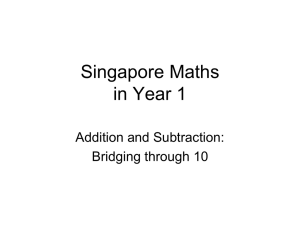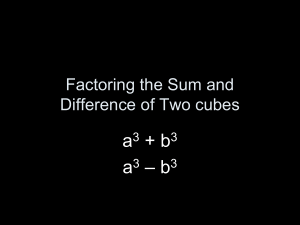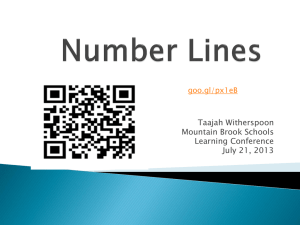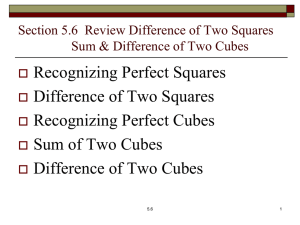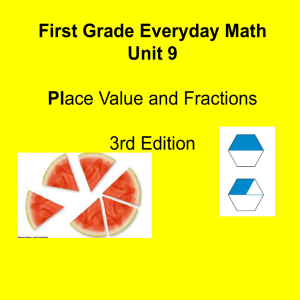Evaluation and Simplify Notes
advertisement
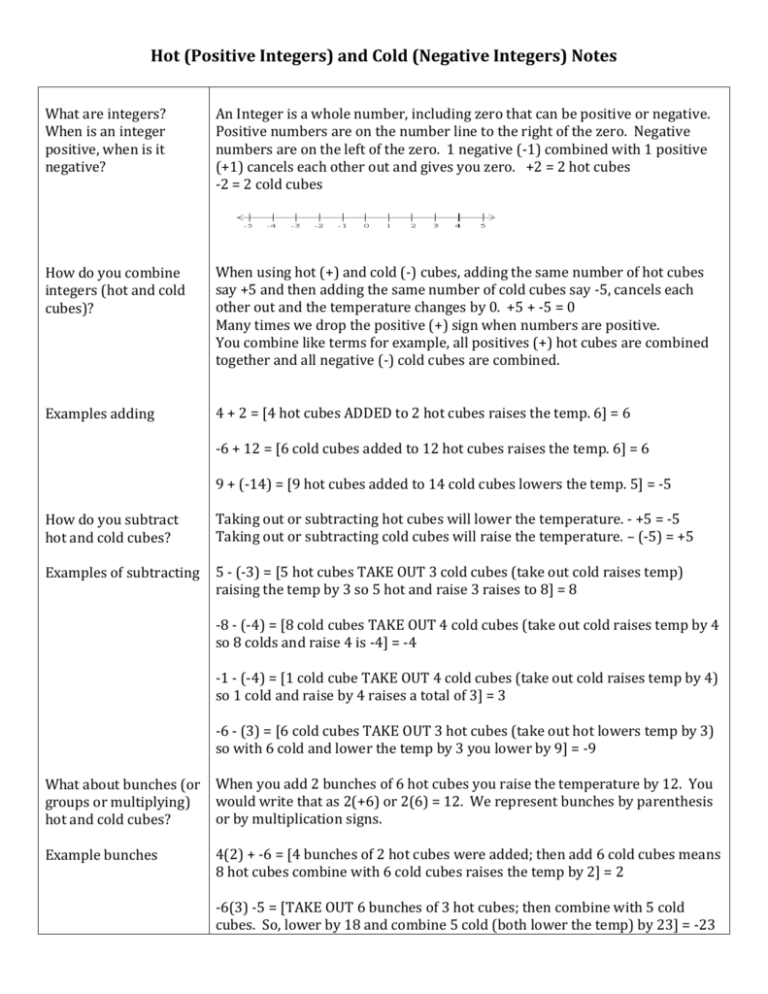
Hot (Positive Integers) and Cold (Negative Integers) Notes What are integers? When is an integer positive, when is it negative? An Integer is a whole number, including zero that can be positive or negative. Positive numbers are on the number line to the right of the zero. Negative numbers are on the left of the zero. 1 negative (-1) combined with 1 positive (+1) cancels each other out and gives you zero. +2 = 2 hot cubes -2 = 2 cold cubes How do you combine integers (hot and cold cubes)? When using hot (+) and cold (-) cubes, adding the same number of hot cubes say +5 and then adding the same number of cold cubes say -5, cancels each other out and the temperature changes by 0. +5 + -5 = 0 Many times we drop the positive (+) sign when numbers are positive. You combine like terms for example, all positives (+) hot cubes are combined together and all negative (-) cold cubes are combined. Examples adding 4 + 2 = [4 hot cubes ADDED to 2 hot cubes raises the temp. 6] = 6 -6 + 12 = [6 cold cubes added to 12 hot cubes raises the temp. 6] = 6 9 + (-14) = [9 hot cubes added to 14 cold cubes lowers the temp. 5] = -5 How do you subtract hot and cold cubes? Taking out or subtracting hot cubes will lower the temperature. - +5 = -5 Taking out or subtracting cold cubes will raise the temperature. – (-5) = +5 Examples of subtracting 5 - (-3) = [5 hot cubes TAKE OUT 3 cold cubes (take out cold raises temp) raising the temp by 3 so 5 hot and raise 3 raises to 8] = 8 -8 - (-4) = [8 cold cubes TAKE OUT 4 cold cubes (take out cold raises temp by 4 so 8 colds and raise 4 is -4] = -4 -1 - (-4) = [1 cold cube TAKE OUT 4 cold cubes (take out cold raises temp by 4) so 1 cold and raise by 4 raises a total of 3] = 3 -6 - (3) = [6 cold cubes TAKE OUT 3 hot cubes (take out hot lowers temp by 3) so with 6 cold and lower the temp by 3 you lower by 9] = -9 What about bunches (or groups or multiplying) hot and cold cubes? When you add 2 bunches of 6 hot cubes you raise the temperature by 12. You would write that as 2(+6) or 2(6) = 12. We represent bunches by parenthesis or by multiplication signs. Example bunches 4(2) + -6 = [4 bunches of 2 hot cubes were added; then add 6 cold cubes means 8 hot cubes combine with 6 cold cubes raises the temp by 2] = 2 -6(3) -5 = [TAKE OUT 6 bunches of 3 hot cubes; then combine with 5 cold cubes. So, lower by 18 and combine 5 cold (both lower the temp) by 23] = -23 -8(-3) - 10= [TAKE OUT 8 bunches of 3 cold cubes, take out cold raises the temp by 24; then combine with 10 cold which lowers by 10 so +24 - 10] = 14 2(-4) – (-3) = [ADD 2 bunches of 4 cold cubes means colder by 8; then TAKE OUT 3 cold cube means raise by 3. So cold by 8 and hot by 3] = -5 Quick Reference and Practice MORE EXAMPLES Combining Integers If both numbers are positive, then the answer is positive: +4 + +6 = +10 If the larger number is positive, then the answer is positive: -5 + +13 = +8 If the larger number is negative, then the answer is negative: -12 + +8 = -4 If both numbers are negative, then the answer is negative: -9 + (-4) = -13 Multiplying Integers If both numbers are positive, then the answer is positive: (+4)(+6) = +24 If one number is negative and the other is positive, then the answer is negative: (-5)(+10) = -50 or (6)(-12) = -72 If both numbers are negative, then the answer is positive: (-9)(-4) = 36 Dividing Integers If both numbers are positive, then the answer is pos: 24/8 = 3 or 24÷8 = +3 If one number is negative and the other is pos, then the answer is negative: (-64)/8 = -8 or 44/(-4) = -11 If both numbers are negative, then the answer is positive: (-36)/(-9) = +4


